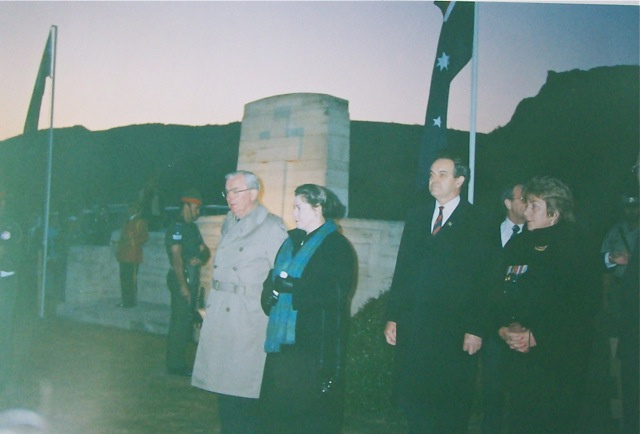Something to Celebrate
Goodbye Cobber. Grave of Trooper Rush, The Nek, Gallipoli.
Tensions ran very high on the last night when the final 10,000 soldiers were withdrawn from Anzac and Suvla. They left the trenches in three main groups ... the first as night fell, the second from about 10 o'clock, and the third in three parties from 1.30 in the morning of 20 December. Men who had protested about the evacuation, now argued to be in the last lot to go. "I've been here from the beginning ... I've a right to be here till the end."
It was bitterly cold, their breath almost turning to ice in the air. They came down to the beaches silently in the moonlight, their boots wrapped in hessian or strips of blanket to muffle the noise. My solider was there to guide them on their way, along the saps and communication trenches lit with shaded candles, or following a trail of flour across open ground to make sure nobody got lost.
Just after midnight a Turkish spotter plane flew across the front. Everybody froze. What if they were seen? Just a few thousand men were holding the whole 11 miles of front line. But nothing ... And at length they continued on to the shore and the string of little boats towed by steam tugs that took them to the waiting ships.
The soldier I'm writing about was in the second group to leave, and watched from the ship’s rail as the last of them left the trenches and came down, the rearguard blowing out the trench candles.
The Nek, looking north to Suvla.
All sorts of devices had been rigged up to make the enemy think the trenches were still manned ... bombs fitted with very long fuses that were lit at the last ... cans with dripping water attached to rifle triggers which, when heavy enough, dropped and caused the weapon to fire... When all the time the time the evacuation was nearly complete.
In fact the last boats left the shores just after 4 o'clock in the morning. Men saw an orange glow in the sky as a huge mine was blown at The Nek, unnecessarily killing many enemy soldiers. For it wasn't until another three hours had gone by that the Turks ventured out in the dawn and saw that their enemy had gone, the ships headed for the island of Lemnos.
There were some unpleasant surprises left behind in the Anzac dugouts, but mostly the departing soldiers had left gifts of food or cigarettes, and notes to say that they hadn't been beaten but left of their own accord. Both sides had come to respect one another as soldiers ... a feeling of mutual regard that continues between our nations to the present day.
A number of historians now are of opinion that the Turks may have guessed what was going on, but didn’t intervene to harass the evacuation from their homeland. If so, it wasn’t a view shared by the men at the time.
The whole move was a wonder...
My soldier wrote home to his wife from Egypt on Christmas Day:
The whole move was a wonder and Turkey didn’t tumble to our leaving or would have given us hell…
It's easy enough to see how the drama of the story gripped me as I came to write of these last two days. Several thousand words just spilled onto the page. And while there's been a school of criticism lately about the militaristic nature of Anzac Day – some of it misplaced, I think, for it's mostly a commemoration not a glorification – it did occur that perhaps we could remember the Evacuation from Gallipoli more overtly than we do the Anzac Day Landings on 25 April.

Bill and Dallas Hayden at Anzac Cove, Gallipoli 1995.
It won't happen of course. But just think about it. It was a withdrawal from the fighting. It was a success. And no Australian or New Zealander was killed. Everybody was a winner.
What do you think?
Photo credits:
Goodbye Cobber – the grave of Corporal Rush, The Nek, Gallipoli: author photo.
The Nek, looking north to Suvla: author photo 2012.
Dawn Service at Anzac Cove, Gallipoli, 1995: author photo.
